Continue your photo travel tour with Joan Ubide, while he’s on his photographic discovery of Nepal.
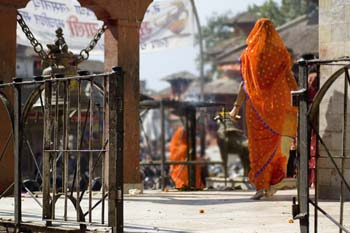
Copyright 2008 Joan Ubide
Durban Temple, Kathmandu
1/1000 F3.5 Iso 125 70mm
Nepal is unique. You can be in the foothills of the Himalayas one minute, and, a few hours later, enter the jungle riding an elephant as if you were in Africa. People there are very close. Although they live in extreme poverty, they put their hands together and offer you a “Namaste,” the traditional greeting of the country.
When I arrived in Nepal, I soon realized I would love the country. After the total chaos at the border with Tibet, I followed the directions of the man who sold the tickets and took a bus to Kathmandu. A few minutes after departure, the bus halted. It had reached its final stop, and the ticket man disappeared, as if by magic. Obviously, I had to go to find another bus and pay again. It took nine never-ending hours to travel the 150 km to the capital city, an exhausting but interesting welcome to Nepal. If you travel in a group, you might be better off hiring a Jeep, which is faster, safer and easier. Buses in Nepal are in very bad condition. They ride on formula 1-style worn-out tires, so that the views of the cliffs you have from the bus windows are disturbing. To make matters even less cheerful, some of the windows have bars.
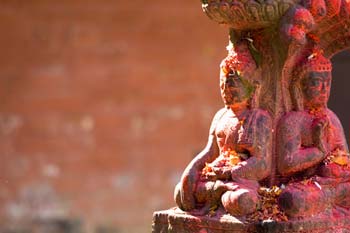
Copyright 2008 Joan Ubide
Temple detail, Kathmandu
1/180 F4.5 Iso 100 180mm
After the serenity of Tibet, I enjoyed the chaos and activity in Kathmandu. It’s a fascinating city that bustles with traffic–klaxons coming from everywhere, all kind of vehicles rushing to and fro, people trying to sell things, cows wandering around, and kids asking for money for cookies. In Kathmandu, everything takes place around the Thamel, a place I recommend you visit for only a few hours. Patan, on the other side of the river, is miles better. There, around Durban Square, you’ll see the same sorts of sights as in Thamel, but much purer, with fewer tourists and no one trying to sell you things. A visit to the Pashupatinath Gates is a must. It will take you back to your childhood memories of The Jungle Book.
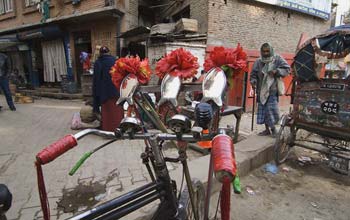
Copyright 2008 Joan Ubide
Thamel, Kathmandu
1/20 F6.3 Iso 125 12mm
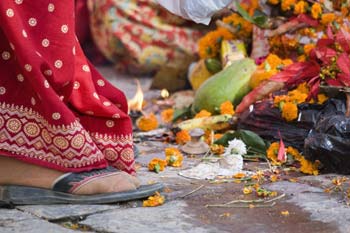
Copyright 2008 Joan Ubide
Detail, Kthmandu
1/160 F4.5 Iso 125 210mm
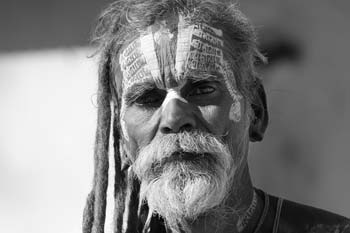
Copyright 2008 Joan Ubide
Pashupatinath Temple, Kathmandu
1/125 F7.1 Iso 100 200mm
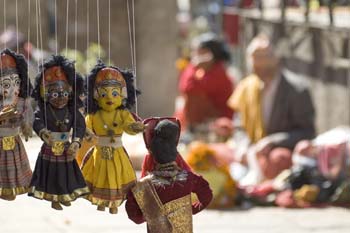
Copyright 2008 Joan Ubide
Detail, Durban Square, Kathmandu
1/640 F3.8 Iso 125 90mm
After spending a few days in Kathmandu and getting my next visa, I headed to Pokhara, a tourist city popular amongst mountain-lovers. (Note: If you plan to travel from Nepal to India and don’t yet have a visa, you need to get one at the Kathmandu embassy, which is a chaotic experience. Instead, you’ll be happier if you obtain one at an agency. I recommend Great Adventure. Contact: Prakash. They’re in the Thamel. It takes 5-6 days to get the visa.) The best thing about Pokhara is the lake, where you can take a boat trip. From there, you can also embark on several trekking routes around the Annapurnas (at the Himalayas). The most popular routes are the Annapurna circuit and the ABC.
I can recommend a couple of places to stay in Pokhara, both on the lake side–the Peace Eye, in front of the Karki house, and the Holly Lodge, on a parallel street. In both of them, you can find a double room for 300 rupees (3 Euro). Eating on the bystreets is half the price of dining in front of the lake.
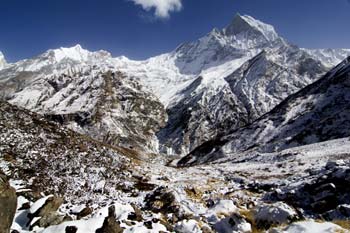
Copyright 2008 Joan Ubide
The Annapurnas, Himalaya
1/160 F13 Iso 100 12mm
Treks
The most popular trek in Nepal is the one to the Everest Base Camp, in the northwest. This trek doesn’t start from Pokhara. You can reach only the Annapurnas from there. The most popular treks are the ABC (Annapurna Base Camp) and the Annapurna Circuit, around the main mountains, which can be done in 15-25 days. The trail is all uphill and downhill, non-stop. If you want to make it in less time, you have to be very fit. It requires walking from 6-10 hours a day, and there are lots of never-ending stone steps through impressive landscapes.
The ABC (Annapurna Base Camp) (permit: 2.000 rupees, around 20 Euro)
I had already seen Mount Everest from the Tibetan side, so I chose the ABC. The trip starts once you travel by taxi to Phedi (400 rupees, around 4 Euro). After a few very steep slopes and the “toll” you have to pay to the Maoists (100 rupees/day), you start to ask yourself if it was a good idea to start this trek. You’ll find many places where you can sleep, eat, rest, or consider whether to go back. Don’t do it! A few hours later, you’ll find suspension bridges, wild jungle, and snow-covered mountains. If you’re lucky, you’ll also see monkeys, and if you’re not very lucky, you might see a leopard. But don’t worry. The appearance of a leopard is very unlikely, and mountain leopards are all vegetarian…
The main towns you’ll find are Pothana, Landruk, Chhomrong, Bamboo, Dovan, Himalaya and Deurali. After them, you’ll enjoy one of the most spectacular views I’ve ever seen–Mount Machhapuchhre (6.998 m). From there, after several hours of walking, you reach the Annapurna south base camp (7.219 m). The base camp is at 4.130 m, and it’s a real wonder. It lies in the center of a great white valley, surrounded by magnificent mountains that turn a reddish shade when sunset comes. You’ll be exhausted, and the air will be extremely cold. So, at 8:00 p.m., you’ll already be in your sleeping bag, covered with several heavy blankets. At 6:00 a.m., you’ll rise to relish a Masala tea and the opportunity to enjoy the dawn in a way that can be described only with pictures.

Copyright 2008 Joan Ubide
A peaceful old man, Chomrong Village
1/30 F2.8 Iso 250 50mm
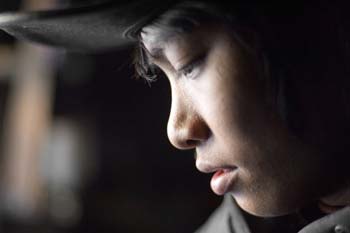
Copyright 2008 Joan Ubide
A boy, Himalaya Village
1/40 F1.4 Iso 400 50mm
The way back runs through the same towns you saw on the way up, but when you get to Chhomrong, you head to Naypul along the side of the Mondi Khola River. The road from Chhomrong is easy, almost no slopes, so the “torture” is reaching its end. It takes about seven days to complete this trek: five days to go up and two days to return down, if you’re traveling an average of 5-9 hours/day. I personally think taking only five days to go up is a bit hard. I recommend taking six days to go up and three days to come back down, so you can enjoy the landscapes and the people. Another attractive option is to do this trek much slower–walking only a couple of hours a day and visiting all the small villages, reading a book, basking in the sun…
Besides the beautiful landscapes, the people and their lifestyle are also highlights. In all the lodges, you can find an assorted menu, from Dalbat to spaghetti and a Coke. You ask yourself, how can a Coke reach the base camp? Well, the answer is easy–on the back of a porter. These people dedicate their entire lives to going up and down the mountains with a basket on their backs. I was struggling to ascend a steep hill, and there was an old lady behind me telling me to move off. I felt suffocated, and she was carrying wood, barefooted. The locals also go downhill in a vertiginous way. It’s impossible to follow them. And everything to earn only a few cents.
Sherpas and guides: Although it’s relatively easy to travel on your own, for a few bucks you can have a guide. It’s very easy to find them. At the Holly Lodge, ask for Dil or contact Tems Sherpa (Sherpa is his name) by e-mail (om_mane88@hotmail.com). The best times of year to visit this area are March, April, August, September and October. February, November and December are cooler. January is rather cold, and in May, June and July, rain is very likely. In any case, you need equipment for low temperatures. You can buy or rent equipment in Pokhara. Please note that before traveling to Nepal, you will be well advised to check the situation between the Army of the country and the Maoist troops. (Right now the situation is relatively calm.)

Copyright 2008 Joan Ubide
The Himalayas, Sherpa in the Annapurna BC
1/40 F13 Iso 200 12mm
Photoshop Art Work on face (levels)
When I got back to Pokhara, I had a couple of days off, a good shave, a massage, and caught another bus. I headed to Sauraha at the gates of the National Park of Chitwan, the main park of the country, a wonder in a totally different environment. Elephants walk the streets among beautiful peoples wearing clothes that make you think of Africa, mud villages, and excellent landscapes by the river. Another less popular but very interesting park is Bardia, in the west.
In Chitwan, I went on a walking tour in the jungle. I was totally scared because the day before, the locals gave me a what-to-do list just in case we encountered wild animals. For example, if you encounter a rhino, you climb a tree. If you run into an elephant, hide in a bush. If you’re confronted by a tiger, move close to the guide and clap your hands loudly. To crown it all, they told me that in recent years, four guides have died protecting their customers. After sharing all these unsettling details with me, they told me to sleep tight.
At 6:00 a.m., alarm clock went off. We started by going canoeing at dawn, amidst the fog, and after watching a crocodile have his morning bath, we entered the jungle. We pushed branches aside as we went, quaking with fear. Suddenly, the guide stopped, directing us to be quiet and come closer, while he pointed his finger at the bushes. It was a butterfly. The guide was laughing his head off. A few minutes later, we made another stop. This time our “danger” was a kind of hen. The guide was splitting his sides with laughter, sputtering, “Chicken jungle! Very dangerous!” In spite of our guide’s good humor, every few meters I chose a tree I could climb, just in case. I made sure everybody else understood which was my tree. We didn’t see any other animals. However, we did find fresh rhino droppings and the marks made by a tiger, which allowed us to end our walking tour scared stiff. It must be true what they say: animals fear us more than we fear them. Anyway, encountering one of these animals is a lottery. The tour group that began after us came face-to-face with a bear, the most dangerous animal of all, according to the guide.
In Chitwan there are more activities to do. Riding an elephant in the park is interesting. I could even see a rhino from my perch. (Maybe the rhino was part of a set-up designed to thrill tourists, but I was very happy to admire that beast from the safety of the elephant.) Renting a bike is a must. You can ride along small paths to find small villages and beautiful, simple-hearted people. It was during one of my walks that I found a children’s home, a small house where sixteen children live with their tutors. An old lady invited me to come in, and I ended up having Dalbat for dinner with them.
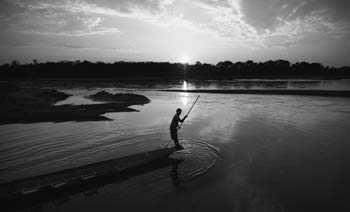
Copyright 2008 Joan Ubide
National Park of Chitwan, Saurah
1/1500 F4 Iso 100 12mm
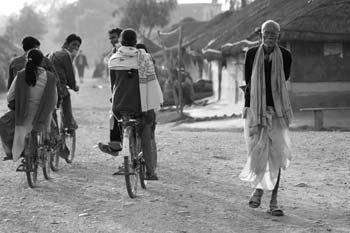
Copyright 2008 Joan Ubide
Lumbini
(The Buddha’s Birth Place)
1/250 F4 Iso 100 105mm
When I started this adventure six months ago, I knew I was doing it because I wanted to travel and have a rest from all those years of working non-stop, taking pictures, and telling my friends and family how I was in my blog. I also wanted to show my work, give my opinion on what I saw, and share my adventures with other people in the hope my experiences would be useful or entertaining. I also wanted to collaborate with a humanitarian cause through NGOs, offering them my services as a photographer to publicize their work, but making the deal wasn’t easy. So, finally, I have decided to do it on a small scale and by myself, helping the people from the Chitwan children’s home. (Please see information on how you can become involved below.)
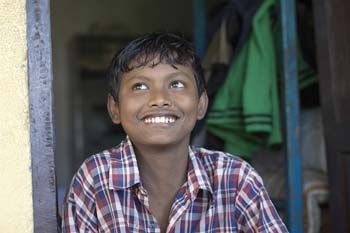
Copyright 2008 Joan Ubide
Preetam
1/40 F2.8 Iso 125 50mm
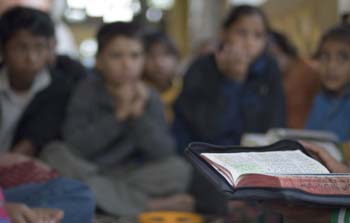
Copyright 2008 Joan Ubide
Pride Time
1/13 F4 Iso 200 24mm
Before entering India, on my way to Sunauli (the border), I went to Lumbini, the place where Buddha was born. My friend Carlos, a cool guy from Madrid that I had met in Annapurna, told me about a ten-day meditation course. So, I thought, “Why not? I can have a smashing time spending Christmas there. They’ll teach me to meditate and disconnect, skills that will suit me very well because my head doesn’t stop. It goes on and on thinking.” So, I registered and told my family I wouldn’t be checking my e-mail for ten days, because I was going on safari. (If I had told them I was going to a temple to meditate, they would have thought I was going nuts.)
By noon, when I reached the place in question, they gave me a sheet of instructions, including these: you can’t talk for ten days, you must wake up at 4:00 a.m. everyday to begin meditating, and you can’t kill any living being. (My room was full of mosquitoes, as well as a considerable clan of wall lizards.) After I had spent the evening, they offered me a sweet white soup for supper and bed time, because at 4:00 a.m., the bells would go “ding dong,” and I would have to go straight to meditation. The next day, I woke up and wrapped myself with the blanket before I followed the rest of those going to meditate to the hall. I sat down and started meditating…on a way to get out of there. In the end, I lasted only one day. I took the first bus I found and went to India by myself. I admire the people who master self-discipline and meditation and are prepared to do what it requires. I wasn’t able. It’s not my thing. Besides, I’m really sleepy at 4:00 a.m.
That’s the last of my tale from Nepal. I’ve already arrived in Varanasi (India). I plan to spend a couple of months traveling across this country from end to end. So, my next article will talk about India whenever I’ve completed this portion of my journey. Before then, I would like to thank Apogee Photo Magazine for their collaboration in publishing my work on their site.
Namaste
Happy 2008
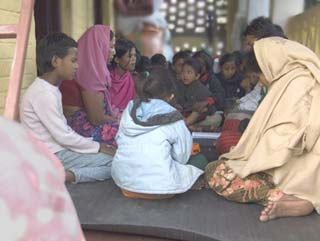
Copyright 2008 Joan Ubide
Pride Time
1/30 F4 Iso 250 24mm
(To focus on the children of the orphanage, this photo has been cropped & digitally enhanced by Apogee.)
I end by sending greetings to Carlos from Madrid (who must still be meditating), Corlius, Marcus and Nadine, to all the “family” from Lhasa–especially to Tanja, Dil and Tems, Nathael and Emilie and to my new friends from this stage. Also, I send my regards to everyone in the orphanage: Sita, Puja, Preetam, Bikash, Mamata, Reya, Deepa, Alisha, Sirjana, Sapan, Deepak, Sunita, Usha, Suresh, Goma, Shoya, Vishu and Vishu Moya.
Readers, I ask you to help these people. It’s very easy. With only 16 Euro, the price of a simple meal out in a Western country, you will pay for the food of one child for a whole month. How can you do it? You can give the money straight to the children’s home. Just print the following text, and proceed, or send the information to your bank with your instructions and the sum you want to give. The bank details of the children’s home are as follows:
NEPAL CHILDREN WELFARE HOME
HIMALAYAN BANK LIMITED
TANDI, BRANCH
S/A – 508270 “J”
SWIFT CODE: HIMANPKA
AMOUNT:
CHITWAN, NEPAL
REFERENCE: http://www.joanubide.com
You can also contribute through Paypal using a credit card. Just visit my web in the section entitled “Children Welfare Nepal.”
If you want to meet the kids, Reya, a girl with no father and a sick mother, or Usha, a little girl who lost her father in 1997 and was abandoned by her mum, I have created an album dedicated to them. You can visit it in my Album section. If you ever travel to Nepal, I recommend that you visit them in person. In the meantime, if you want to stay informed about them, I recommend that you subscribe to my web. You won’t receive any spam, only mail whenever I have news. You can also use the RSS system.
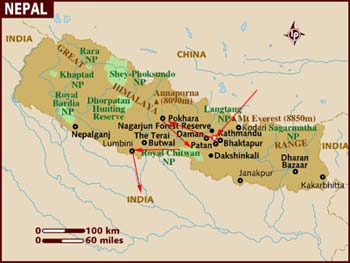
I think the album about Nepal, together with the album about the children’s home, are my best works as a photographer. They include nearly 250 pictures, covering Kathmandu to the Himalayas and the National Park of Chitwan. You’ll need to take some time to enjoy it all. I hope you can find a moment to do it and that it helps you to understand my words.
You can even send the information to your friends and contacts. I’ll try to find a newspaper where I can publish the pictures. If you know any magazine or other media that could be interested, please ask them. I give this work about Nepal for free. A publication has only to contact me at joan@joanubide.com. Companies can also collaborate as sponsors. I’ll be glad to include a mention of their participation and a link to their websites.
To see more photos on Joan’s trek through Nepal, visit…
Visit Part 1: Mongolia
Visit Part 2: China
Visit Part 3: Tibet
Visit Part 5: North India
Visit Part 6: South India
Visit Part 7: Iran
by Joan Ubide

Leave a Reply